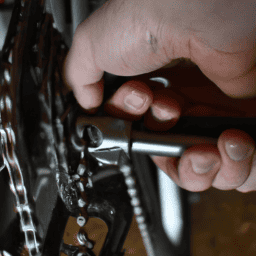Have you ever pondered why a bicycle remains balanced as you pedal along? Even though you’re always adjusting your posture and making slight changes to the steering, the bicycle manages to maintain its stability and equilibrium.
The answer to this question lies in a combination of factors, including the gyroscopic effect, steering geometry, and the role of the rider.
The gyroscopic effect refers to the tendency of a spinning object to maintain its orientation in space. When you pedal a bicycle, the wheels spin rapidly, creating a gyroscopic effect that helps keep the bike upright.
In addition, the design of the bike’s frame and fork creates a stable base that resists tipping over. However, this is only part of the story.
The rider also plays a crucial role in maintaining balance, using their body weight and steering to make constant adjustments as they ride. Together, these factors work in harmony to create the seemingly effortless balance that allows you to ride a bike with ease.
Key Takeaways
- Bicycle stability is influenced by various factors such as gyroscopic effect, steering geometry, rider’s body weight and adjustments, leaning, countersteering, speed, and road conditions.
- Proper weight distribution, core muscle stabilization, and anticipating terrain changes can improve bicycle stability.
- Designers can improve bicycle stability through frame design, aerodynamics, material innovations, wind tunnel testing, and computer simulations.
- Understanding bicycle stability can lead to improved balance, control, efficiency, and a more stable and controlled riding style.
The Gyroscopic Effect
You’ll feel the gyroscopic effect when you turn the wheels of your bike, as it helps to keep your bike balanced and stable while in motion. This effect is created by the spinning of the wheels, which creates a force that acts in a direction perpendicular to the spinning axis. This force is known as the gyroscopic force, and it helps to keep the bike upright by resisting any forces that might cause it to tip over.
One way to demonstrate the gyroscopic effect is through a precession demonstration, where a spinning wheel is suspended on a stand and a force is applied to the axis of rotation. Instead of the wheel tipping over, it actually precesses, or rotates, around the applied force. This is because the gyroscopic force is acting at a right angle to the applied force, causing the precession.
In the real world, the gyroscopic effect is used in many applications, such as in aircraft and spacecraft control systems, where it helps to keep them stable and on course.
As important as the gyroscopic effect is, it’s only one factor in how a bicycle stays upright. The other key factor is the steering geometry, which we’ll explore in the next section.
Steering Geometry
When you’re riding your bike, the angle of the fork and the position of the handlebars affect how easily you can turn. This is due to the concept of steering geometry, which refers to the relationship between the front wheel, the handlebars, and the fork. The two main factors that determine steering geometry are the trail measurement and the fork angle.
Trail measurement is the distance between the point where the front wheel touches the ground and the point where an imaginary line extended from the steering axis would touch the ground. This measurement affects how easily the bike can be turned at high speeds and how stable it is when going straight. A larger trail measurement results in a more stable bike, but it may be more difficult to turn quickly. The fork angle, on the other hand, determines the responsiveness of the bike. A smaller fork angle allows for quicker turns, while a larger angle provides more stability at high speeds. By understanding these factors, you can adjust the steering geometry of your bike to suit your riding style.
As you can see, the steering geometry of your bike plays a crucial role in how it handles. However, it’s important to remember that the rider also has a significant impact on the bike’s stability and maneuverability. In the next section, we’ll explore the role of the rider and how they can affect the bike’s balance and control.
The Role of the Rider
When it comes to maintaining stability on a bicycle, the rider plays a crucial role. Your movements, balance techniques, and body positioning all affect how well you stay upright.
Understanding how to properly position your body, shift your weight, and use your arms and legs to maintain balance can make a significant difference in your overall ride experience. So, if you want to improve your cycling skills, it’s important to pay attention to the impact your body has on the bike’s stability.
How the Rider’s Movements Affect Stability
As the rider shifts their weight, it affects the stability of the bicycle. Riding technique and weight distribution play a crucial role in maintaining balance while riding.
For instance, when you lean forward, your center of gravity shifts forward, causing the front wheel to bear more weight. This, in turn, increases the traction and stability of the front wheel. On the other hand, leaning backward shifts your center of gravity towards the rear wheel, making it more stable on slippery or loose surfaces.
Moreover, when you turn, your weight should shift in the opposite direction to the turn. This technique is referred to as counter-steering, and it involves pushing on the handlebars in the opposite direction of the turn. Doing so causes the bike to lean in the opposite direction, and the turn becomes more controlled.
With these techniques in mind, you can improve your riding skills and maintain stability while riding. Now, let’s explore balancing techniques that can further improve your stability.
Balancing Techniques
Mastering balancing techniques on a bike is key to staying in control and enjoying a smooth ride. There are several ways to maintain balance on a bicycle, such as adjusting your center of gravity and utilizing countersteering.
Here are three techniques you can use to improve your balancing skills:
-
Keep your eyes up and focus on the horizon. This will help you maintain a straight line and avoid swerving.
-
Shift your weight slightly to one side or the other to help maintain balance. For example, when turning left, shift your weight to the left side of the bike.
-
Use countersteering to initiate turns. To turn left, push the handlebars to the right, and to turn right, push the handlebars to the left.
By utilizing these techniques, you can improve your balance and control on a bicycle. However, it’s important to also pay attention to body positioning, which will be discussed in the next section.
Importance of Body Positioning
Proper body positioning is crucial to achieving balance and control on your bike. The importance of posture can’t be overstated as it directly affects your stability on the bike.
Your upper body should be relaxed, with your core engaged and your shoulders level. This helps to distribute your weight evenly and maintain your center of gravity.
Additionally, muscle engagement during riding is another key factor in maintaining stability. Your legs should be active in pedaling, but also in absorbing shocks and maintaining a steady cadence. Engaging your glutes and lower back muscles helps to stabilize your lower body and prevent swaying.
By maintaining proper body positioning and engaging your muscles, you can improve your balance and control on your bike.
As important as body positioning and muscle engagement are, there are other factors affecting stability on a bike. These include speed, terrain, and wind conditions. By understanding these factors, you can adjust your riding technique and maintain control in any situation.
Other Factors Affecting Stability
Now let’s delve into other factors that can affect the stability of a bicycle.
First, speed and momentum play a crucial role in maintaining balance. As you increase your speed, it becomes easier to balance due to the gyroscopic effect of the spinning wheels. However, sudden changes in momentum can also lead to loss of balance.
Second, road conditions can greatly impact stability. Uneven surfaces, potholes, and debris can cause the wheels to wobble or even slide, making it harder to keep the bike upright.
Third, weight distribution is another factor to consider. A poorly balanced load can throw off the center of gravity and make it difficult to maintain stability.
Speed and Momentum
You can feel the rush of wind as you pick up speed on your bike, and the momentum keeps you upright as you glide along the road. The faster you go, the more stable your bike becomes. As you accelerate, the gyroscopic effect of the wheels increases, making it more difficult for the bike to tip over. This is due to the wheels’ angular momentum, which causes them to resist changes in direction.
In addition to acceleration effects, aerodynamics also come into play. As you ride faster, the air resistance increases, creating a stabilizing force that helps keep your bike upright. This is why you may notice that your bike feels more stable at higher speeds. However, it’s important to note that there is a limit to how fast you can go before the aerodynamic forces become too strong and destabilize your bike. This is why it’s important to always ride within your limits and be aware of road conditions.
As you can see, speed and momentum play a significant role in keeping your bike upright. But, as we’ll see in the next section, road conditions can also have a big impact on your bike’s stability.
Road Conditions
When riding on bumpy or uneven roads, it can be challenging to maintain control of your bike. The irregularities on the road can cause vibrations that can throw off your balance. To reduce these vibrations, it’s important to optimize your tire pressure. The right tire pressure ensures that your bike absorbs the shocks from the road, allowing for a smoother ride.
Reducing vibrations is crucial to ensure that your bike stays upright, but so is proper weight distribution. The weight distribution of your body and the bike affects how it handles on the road. When going over bumps or uneven terrain, it’s important to shift your weight to compensate for the jolts. The right balance allows for better control and easier maneuvering.
By understanding how road conditions affect your bike’s stability and making the necessary adjustments, you can ensure a safer and more enjoyable ride.
Weight Distribution
Feeling like a pro rider requires you to master weight distribution while on your bike. Understanding how to balance your weight properly on the bike will help you stay upright and in control. Weight distribution is all about keeping your center of gravity over the bike’s center of gravity.
When you’re sitting on your bike, your body’s weight is distributed between the front and rear wheels. The front wheel carries more weight when you’re leaning forward, while the rear wheel carries more weight when you’re leaning back. To maintain balance, you must shift your weight slightly forward or backward depending on the terrain and your speed.
The key is to keep your center of gravity in line with the bike’s center of gravity. By doing so, you’ll be able to maneuver your bike with ease and confidence. Practical applications of weight distribution include knowing when to lean forward or backward to climb or descend hills, and how to properly position yourself while riding over bumps or around corners.
By mastering weight distribution, you’ll be able to handle your bike with precision and control, making your rides smoother and more enjoyable.
Practical Applications
If you want to improve your riding, understanding bicycle stability is key. By grasping the science behind how a bicycle stays upright, you can adjust your balance and control for better performance.
But it’s not just about individual riders – designers also benefit from this knowledge, as they can create more stable bicycles that are safer and easier to ride. With advancements in bicycle technology, we can continue to push the limits of stability and innovation in the world of cycling.
How Understanding Bicycle Stability Can Improve Riding
You can improve your riding by understanding how bicycle stability works. By doing so, you’ll be able to adjust your body mechanics and improve your balance while on the bike. This will allow you to ride with more confidence, control, and efficiency.
To improve your riding, here are three key concepts to consider:
-
Keep your weight centered over the bike’s center of gravity. This is crucial for maintaining stability, especially when going over bumps or making turns.
-
Use your core muscles to stabilize your upper body. By engaging your core, you can keep your upper body stable while your legs pedal and steer the bike.
-
Look ahead and anticipate changes in terrain. By keeping your eyes on the road ahead, you can prepare for any obstacles or changes in terrain and adjust your body position accordingly.
Understanding these concepts and incorporating them into your riding technique can make a big difference in your performance on the bike. With practice, you can develop a more stable and controlled riding style, allowing you to tackle more challenging terrain and ride with greater confidence and ease.
Moving on to the next section, designing more stable bicycles is the next step in improving your riding experience.
Designing More Stable Bicycles
Now that you understand how bicycle stability can improve your riding, let’s dive into designing more stable bicycles. One key component to consider when designing a stable bicycle is the frame. The frame should be designed to distribute the rider’s weight evenly, as well as provide a low center of gravity. This allows for better balance and control, especially when turning or cornering.
Another factor to consider is aerodynamics. A bicycle that is more aerodynamic will face less air resistance, making it easier to ride and maintain stability. This can be achieved through various design elements such as a sloping top tube or a streamlined fork. By taking these factors into consideration, designers can create bicycles that are not only stable, but also efficient and easy to ride.
Moving forward, advancements in bicycle technology continue to push the limits of what is possible. Let’s explore some of these exciting developments in the next section.
Advancements in Bicycle Technology
With the constant push for innovation, the world of cycling technology continues to evolve, bringing forth exciting advancements in the field. Material innovations have allowed for lighter and stronger frames, making bicycles more efficient and durable. Carbon fiber, for example, is a popular material used in high-end bicycles due to its strength and lightness.
And with the development of 3D printing technology, custom frames can now be produced with precision and speed, allowing for a more personalized riding experience. Aerodynamic design has also played a crucial role in the advancement of bicycles. Wind resistance can greatly affect a cyclist’s speed, and with the use of wind tunnel testing and computer simulations, designers are able to create bikes with optimized shapes and angles.
Integrated handlebars and cables, as well as streamlined wheel designs, reduce drag and increase speed. With all these advancements, it’s no surprise that cycling technology continues to evolve, making the ride smoother, faster, and more enjoyable for cyclists everywhere.
Frequently Asked Questions
What are some common mistakes that new riders make that can affect the stability of a bicycle?
When new riders focus too much on steering, they may forget to balance themselves properly. This can cause the bike to wobble or even fall over. Counterbalancing techniques, such as shifting weight, can help maintain stability.
How does the weight distribution of the rider and the bike affect the bike’s ability to stay upright?
Your weight distribution affects the bike’s center of gravity. Leaning too much can throw off the balance, while countersteering can help correct it. Understanding these principles is crucial for maintaining stability on a bicycle.
Can different types of tires affect the stability of a bicycle?
Tire pressure and tread design can impact the stability of a bicycle. Low tire pressure can cause the bike to wobble, while a tread design that doesn’t provide enough grip can lead to slipping.
Does the speed at which a bicycle is traveling have an impact on its stability?
As you pick up speed on your bicycle, the impact of wind can cause some instability. Additionally, a steep gradient or uneven road surface can affect stability. These factors must be accounted for in the technical analysis of bicycle stability.
Are there any specific riding techniques or maneuvers that can help maintain the stability of a bicycle?
Maintaining a stable ride requires proper posture and countersteering. Braking techniques and body positioning can also help prevent loss of balance. These maneuvers are essential for cyclists to master in order to ride safely and confidently.
Conclusion
Congratulations, you now know how a bicycle stays upright! The bike is able to maintain its balance and prevent itself from falling over through the combination of the gyroscopic effect and steering geometry. However, it’s important to note that the rider also plays a crucial role in the bike’s stability. By adjusting their weight and making small steering adjustments, the rider helps keep the bike on track.
But wait, there’s more! Other factors, such as the weight distribution of the bike and the quality of the road surface, can also affect stability. It’s important to keep these in mind when riding and to always be aware of your surroundings.
Overall, the science behind a bicycle’s stability is truly fascinating and complex, but with practice and understanding, you can confidently ride your bike with ease. You might even say it’s a piece of cake!
















